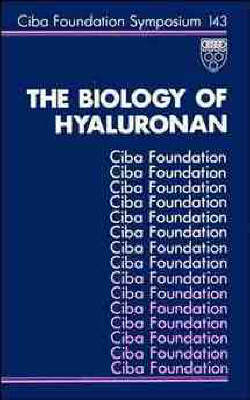The Biology of Hyaluronan Chairman: T. C. Laurent 1989 Hyaluronan is a unique linear polysaccharide found in cartilage and in soft connective tissues such as synovial fluid and skin. It is an apparently simple homopolymer with a mechanical role as space filler or lubricant which also takes part in cell surface activities of great specificity, as recent work described in this symposium shows. Hyaluronan synthase was first identified in streptococci; isolation of the mammalian enzyme and its properties are discussed. The degradation of hyaluronan is mainly intracellular after receptor-mediated uptake. The catabolic enzymes involved and the fate of the resulting monosaccharides (including their recycling) are becoming understood. Various hyaluronan-binding proteins have been identified, including one in fibroblasts which may help regulate cell motility. Hyaluronan is a major component of the intercellular matrix surrounding proliferating and migrating cells in embryonic tissues, including the developing nervous system. It is involved in inflammation, angiogenesis and wound healing.
High concentrations are found in malignant tissues, the result (in culture at least) of stimulation of hyaluronan synthesis in fibroblasts by tumour cells. Another stimulatory factor, produced by activated blood mononuclear cells, links hyaluronan to inflammatory diseases such as scleroderma and rheumatoid arthritis. High levels are produced in cirrhotic liver disease, malignant mesothelioma and sarcoidosis. The clinical use of hyaluronan as a connective tissue marker is leading to a better understanding of such diseases. The symposium concludes with a discussion of the surgical use of purified hyaluronan, including the development of new molecular forms for use in the control of adhesions, scar formation and tissue regeneration. Related Ciba Foundation Symposia: No 124 Functions of the proteoglycans Chairman: V. C. Hascall 1986 ISBN 0 471 91090 2 No 136 Cell and molecular biology of vertebrate hard tissues Chairman: G. A. Rodan 1988 ISBN 0 471 91885 7 No 145 Carbohydrate recognition in cellular function Chairman: E. Ruoslahti 1989 ISBN 0 471 92307 9
- ISBN10 0471923052
- ISBN13 9780471923053
- Publish Date 14 June 1989
- Publish Status Out of Print
- Out of Print 18 February 2022
- Publish Country GB
- Publisher John Wiley and Sons Ltd
- Imprint John Wiley & Sons Ltd
- Format Hardcover
- Pages 308
- Language English
